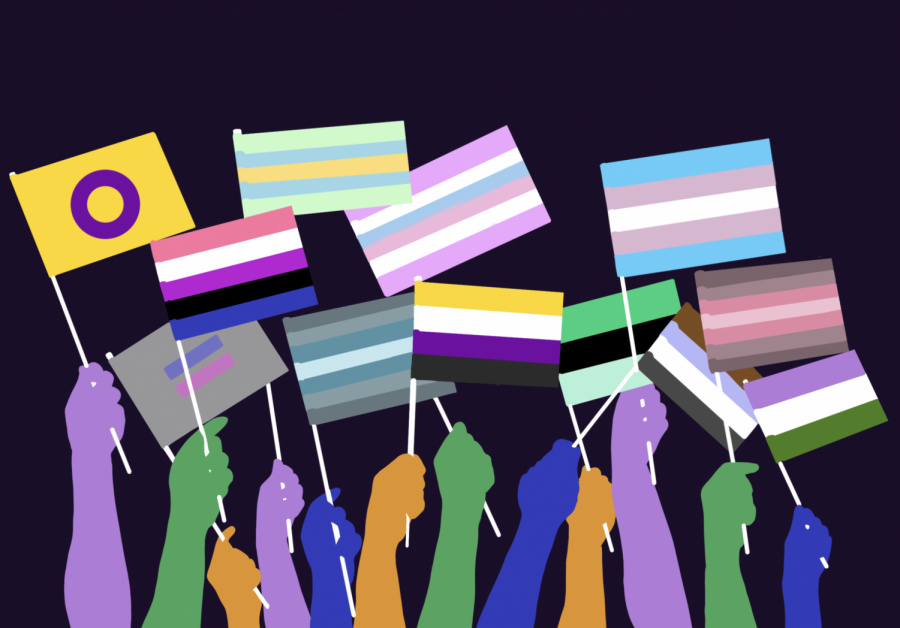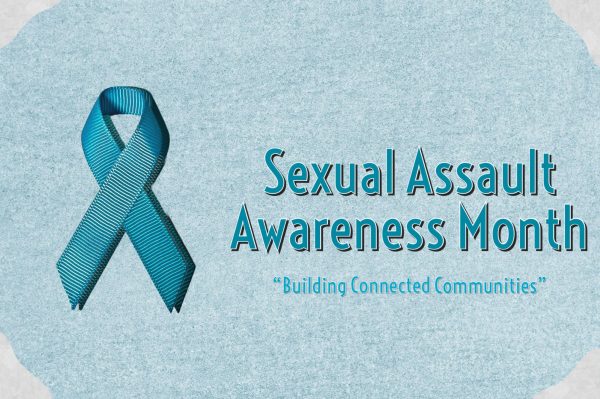Busting Bliss: Gender Nonconformity
Our understanding of gender and sexuality is evolving, but further progress requires as much un-learning as it does learning.
digital art by Julia Poppa
Although it is praiseworthy that social acceptance of the full spectrum of sexualities and genders has entered the mainstream, there is still more work to be done.
December 15, 2020
TW: Mentions of suicide, hate crimes, and death.
“Sit like a lady.”
“Man up.”
Throughout our childhood, perceived gender norms loom over us.
Maybe you were told that the toy you wanted was for boys, not for girls, and that’s why you couldn’t have it. Or maybe you were subtly dissuaded from dance lessons because boys tend to play sports instead.
But the culture is changing. As far as acceptance goes in regard to gender identity we’ve come a long way.
In the past few months, TikTok has seen a rise in videos of boys wearing skirts, dresses, and even maid outfits as a way to experiment with their masculinity and break gender norms. Harry Styles became the first man to grace the cover of Vogue solo, wearing an androgynous adaptation of a ball gown, no less. Even the star of hit series, The Umbrella Academy, Elliot Page, recently came out as trans on their social media platforms.
But why does gender matter anyway, and why do we make such a big deal about it? It’s important to understand the difference between sex and gender and how each affects the other before we dive into why opposition to deviation from gender norms continues to breed hatred and destruction.
Sex versus Gender
Oftentimes, people who are transphobic resort to one of two arguments: “There are only two genders” or “you can’t be this if your genitals are that.” At the base of every argument is you should act, dress, and identify based off of your genitalia.

However, such positions are not based in truth. Most people tend to confuse sex with gender, which makes sense. There are very few resources for people to learn what the difference is, especially when this kind of education is lacking in the formative years– when we are able to grasp the concept of different biologies.
Sex
The most common notion thrown around gender conversations is that there are only two genders. Male and female, boy and girl, penis and vagina. The argument not only reduces a person’s biology and sex to their genitalia, but it’s technically not right either. There actually are more than two sexes.
Sex references a person’s biology, typically associated with the male/female binary, characterized by sex chromosomes, typically XX and XY.
One of the key arguments against gender is that one’s gender is based on primary and secondary sex characteristics, and that these only consist of the aforementioned XX and XY variations. However, not only are there people who are born intersex— a fascinating topic, far too intricate for me to do justice to in the space of one article — but there are also people who are biologically male, but born with XX chromosomes, and born biologically born female, but with XY chromosomes.
There are a lot of different variations of sex chromosomes beyond XX and XY. There are trisomy disorders, in which a person is born with an additional X or Y chromosome (XXX, XXY, XYY), and even more rarely, tetrasomies, which adds an additional X or Y chromosome to a trisomy.
These are complicated and difficult topics to understand, but as long as we understand that the sex binary isn’t entirely accurate, we’re on the right track.
Gender
Gender, on the other hand, can be a lot more difficult to make sense of, for a lot of different reasons.
Gender refers to the socially constructed roles of each sex in society. If you’ve ever heard the saying “gender is a social construct,” well, it’s right there in the definition.
Gender roles vary in rigidity based on the culture, and there’s a vast and interesting history of gender roles in different cultures, which I’ll attempt to discuss later. But right now, let’s talk about the gender binary.
Not to be confused with the sex binary, which we’ve already debunked, the gender binary doesn’t really exist either. You’ve heard “gender is a social construct,” but try this one: “gender is a spectrum.”
A lot of the time, sex and gender tend to align — no cause for concern, no harm done. But as society is progressing past the need for gender roles and into acceptance, a lot of people have realized the terms male and female don’t really fit.
Gender identity is how someone feels in relation to the gender spectrum, and it varies from male to female to somewhere in the middle, or a combination of the two, or neither.
Why someone identifies a certain way is frankly no one else’s business, but it is important to respect how a person identifies — it’s something that only they are able to decide for themselves. It’s therefore hurtful and immoral to tell them that they’re wrong about who they are or to invalidate their identity— even if we don’t understand it.
There are a lot of different gender expressions and a lot of different labels to go with them. Before I dive into the main categories of what they are, I’ve had a lot of conversations with people who say they don’t understand labels, and that’s okay, as long as we can understand that those labels are important to some people and can provide a sense of community for them.
The truth is, we don’t have to understand a person’s identity for it to be valid. Whether our lack of understanding comes from ignorance or the inability to grasp the concept, all that essentially matters is respect.
Let’s Talk Respect
As we grow up, we are all taught about respect — but all too often, were choose who deserves our respect and who does not. Respecting a person for who they are fundamentally at their core, stripped of political stance, background, opinion, etc. should be a given, but it is rarely the case.
When I talk about respecting another person fundamentally, I mean respecting how they identify themselves, whether that’s gender, sexuality, or both. Our identity is essential to the rest of our personality and character. Even if a person’s character or personality are not worth respecting, who they are– at their most essential core– is.
For example, Ezra Miller, a well known non-binary actor, who uses they/them pronouns, was seen assaulting a fan by choking them at a bar in Reykjavik, Iceland earlier this year. Now, many people who consider themselves “accepting” have used this as an excuse to use the incorrect pronouns for Miller— resorting to he/him.
Do I respect Miller for assaulting a fan? Absolutely not, but someone’s actions— however horrible— do not invalidate their identity and are not an excuse to do so intentionally.
Most recently, the star of The Umbrella Academy, Elliot Page, came out as trans, saying that they would like to be referred to as Elliot, and with both he and they pronouns. Unfortunately, many media outlets continue to refer to them as “Ellen” Page— a practice commonly known as deadnaming, and similarly, continue to use the pronouns she and her in reference to them.
Deadnaming is a common practice that many trans people are used to, but being accustomed to blatant disrespect doesn’t make it any better. The act of coming out as trans is difficult as it is, and for many, acceptance is key to validating the struggle of both figuring out their identity and being able to admit it to others.
Sadly, it seems people are more likely to apologize for misgendering your dog on the street than they are to apologize for misgendering an actual human being.
89% of trans individuals have had suicidal ideations, while 27% have attempted it, and according to resources from the Human Rights Campaign, there have been at least 41 cases of transgender or gender non-conforming people who have been fatally shot or killed — a majority of whom were trans women of color.
When we talk about respect, even about notions as simple as using someone’s chosen name or pronouns, it is not simply about being kind. To consciously make attempts to be accepting can go much further than one might think.
The Problem with White Gender Nonconformity
Now that we’ve broken down the binary system and talked about respect, let’s discuss some more pressing matters regarding modern gender nonconformity.
Gender nonconformity encompasses many things, from how someone identifies themselves to how they fit into society’s gender roles— there are a lot of ways to break free of the constraints of gender.
Recently, there has been a surge in men redefining what it means to be masculine. The rise of men playing with femininity gained its foothold on TikTok, as boys on the app started wearing skirts and dresses because, well, they simply felt like they could.
Acceptance surrounding men redefining their masculinity has soared since the trend took off, and soon after, Harry Styles became the first man to cover Vogue alone, and wearing a dress of all things.
Of course, there was controversy surrounding both events, but largely, people of all ages and genders were happy to see gender being redefined on a larger scale. It is undoubtedly a wondrous step in the right direction, and the overwhelming support was both astounding and necessary, but by no means is the fight for acceptance over.
At first, when I saw Styles was on the cover of Vogue in a dress, my reaction was to be elated— I was and still am, don’t get me wrong. But the longer I looked, I realized that his dress, while still a dress, was androgynous— a mere shadow of a ball gown draped over an otherwise very masculine suit. Still, this didn’t bother me much until I realized that a white man was about to become the face of gender nonconformity for donning a garment considerably less feminine compared to something his non-famous, non-white counterparts wear on a daily basis.
There isn’t an issue with a white, straight, cisgendered man wearing a dress or being on the cover of a magazine doing so. However, the widespread support for Styles has overshadowed trans and gender nonconforming people of color, who have historically lived these identities for much longer and have received much more hate.
Indigenous cultures consist of members identifying as two spirit, some Indonesian cultures that recognize five genders, Kenya and Tanzania having the term “mashoga” referring to men who adopt the female gender early in life, even the underground ball culture in New York City, which emerged in the early 1920’s and grew more and more racially diverse as the years went on. There are too many others examples to name them all.
So when I saw an article from The Guardian — headlined “How Harry Styles became the face of gender-neutral fashion”– I was shocked. Toting around Styles as the “face” of the gender queer movement is an act of erasure against the cultures that have systematically been harmed for exhibiting near similar behaviors for centuries.
In an episode of The Trypod, from popular creators The Try Guys, Eugene Lee Yang, a queer creator himself, spoke out about the erasure as well. In their conversation, they discussed how right-wing politicians and supporters speaking against this movement is more detrimental to those of color than it is to the white people they talked about.
“If you think about what they’re indoctrinating, it’s not, ‘Oh, I’m going to be mad just because I see, like, a magazine cover of someone who I identify as masculine looking wearing a dress. I’m going to be mad when I see a trans person walking down the street,’” Lee Yang said. “‘I’m going to be mad when I see a group of gay people wearing things that are non-binary, and I might actually attack them.’”
He continued, “In the end, the only people that get hurt from this are the people that are already the most vulnerable.”
And I couldn’t agree more. As I mentioned earlier, people of color are at a much higher risk of being attacked for being trans. 47% of Black trans Americans, and 30% of Latinx trans Americans reported being verbally and/or physically assaulted in the past year alone.
Even on TikTok, the videos of boys wearing skirts that are boosted by the algorithm and end up on the “for you page” consist mostly of cisgender white men. This is why it is especially important to have conversations with and support trans and gender nonconforming people of color.
Issues of race, gender, and sexuality are all intersectional, and even though issues of race may have taken the forefront of human rights and civil rights movements this year, it’s imperative that we as a community make an effort to understand the other issues affecting the queer community — especially those members who are at a disadvantage due to their identity.
Acceptance is not difficult. It just requires both learning and unlearning transphobic sentiments. However big or small they might be, we all have them, and we can do better — we just have to take the time to listen.
******
Here are some links to resources to transgender rights activists, resources to better understand how to be an ally to transgender and gender nonconforming people, and trans-inclusive media.
Resources:
Tips for Allies of Transgender People
Understanding the Transgender Community
How to be a better ally to non-binary people
Activists:
Media:
Pose (TV show)
Disclosure (Documentary)
Transparent (TV show)
Paris Is Burning (Film)
This story was originally published on The Uproar on December 15, 2020.



























![IN THE SPOTLIGHT: Junior Zalie Mann performs “I Love to Cry at Weddings,” an ensemble piece from the fall musical Sweet Charity, to prospective students during the Fine Arts Showcase on Wednesday, Nov. 8. The showcase is a compilation of performances and demonstrations from each fine arts strand offered at McCallum. This show is put on so that prospective students can see if they are interested in joining an academy or major.
Sweet Charity originally ran the weekends of Sept. 28 and Oct. 8, but made a comeback for the Fine Arts Showcase.
“[Being at the front in the spotlight] is my favorite part of the whole dance, so I was super happy to be on stage performing and smiling at the audience,” Mann said.
Mann performed in both the musical theatre performance and dance excerpt “Ethereal,” a contemporary piece choreographed by the new dance director Terrance Carson, in the showcase. With also being a dance ambassador, Mann got to talk about what MAC dance is, her experience and answer any questions the aspiring arts majors and their parents may have.
Caption by Maya Tackett.](https://bestofsno.com/wp-content/uploads/2024/02/53321803427_47cd17fe70_o-1-1200x800.jpg)
![SPREADING THE JOY: Sophomore Chim Becker poses with sophomores Cozbi Sims and Lou Davidson while manning a table at the Hispanic Heritage treat day during lunch of Sept 28. Becker is a part of the students of color alliance, who put together the activity to raise money for their club.
“It [the stand] was really fun because McCallum has a lot of latino kids,” Becker said. “And I think it was nice that I could share the stuff that I usually just have at home with people who have never tried it before.”
Becker recognizes the importance of celebrating Hispanic heritage at Mac.
“I think its important to celebrate,” Becker said. “Because our culture is awesome and super cool, and everybody should be able to learn about other cultures of the world.”
Caption by JoJo Barnard.](https://bestofsno.com/wp-content/uploads/2024/01/53221601352_4127a81c41_o-1200x675.jpg)














